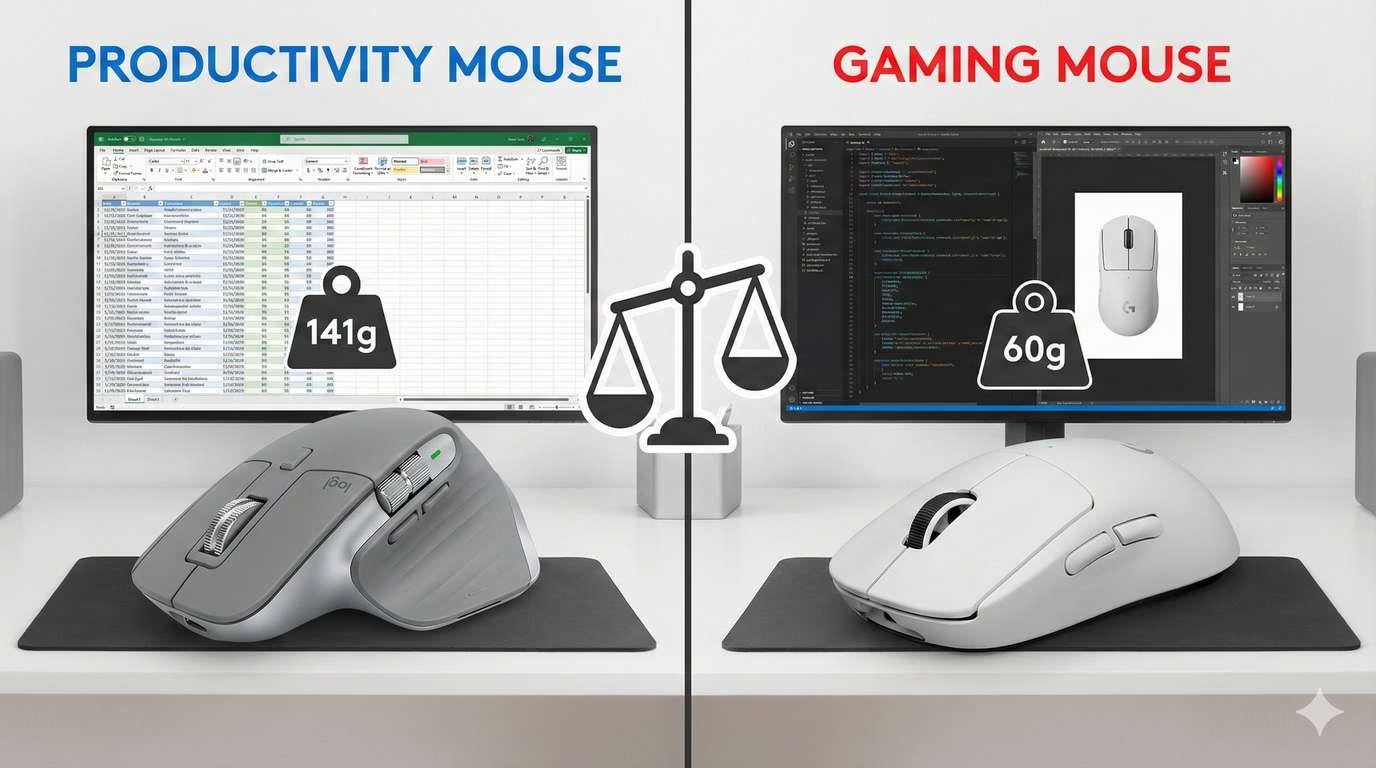Stuck between the MX Master 3S and Superlight 2? We compare weight, features, and fatigue to find the real best mouse for productivity.
Table of Contents
The Great Divide — Gaming Mouse vs Productivity Mouse
Ask most people which mouse to buy for work and 90% will say the MX Master. It’s everywhere for a reason: buttons, wheels, and comfort baked in.
But a new crowd — coders, editors, spreadsheet jockeys — is switching to ultralight gaming mice. Why? Because weight changes how your hand feels after eight hours. This post pits Logitech’s MX Master 3S (the productivity standard) against the Logitech G Pro X Superlight 2 (the lightweight challenger) and gives you a blunt, experience-based verdict. You might also like to read: lightweight gaming mouse for work.
Round 1: Weight and Fatigue — The Game Changer (mouse weight fatigue)
Numbers matter: MX Master 3S ≈ 141 g. Superlight 2 ≈ 60 g. Those are not marketing decimals — they’re how much inertia your wrist fights all day.
Move 141 g for eight hours and your forearm notices. Move 60 g and it feels like the mouse is doing the work for you. That difference shows up as two things: speed and soreness.
What it feels like after a day:
- MX Master 3S: more deliberate movements. Great for ergonomic wrist posture, worse if you’re constantly dragging across large screens or multiple monitors. Wrist and forearm fatigue builds slowly.
- Superlight 2: ultra-easy flicks and long cursor trips. You’ll finish spreadsheets faster and with less micro-tension in the extensor muscles.
Practical verdict: if you regularly move the cursor long distances or use multiple monitors, the lower weight reduces repetitive strain fatigue. For many professionals that alone is enough to consider a gaming mouse.
Round 2: The Scroll Wheel — The MX Master’s knockout punch (best mouse for Excel)
MX Master 3S has the MagSpeed electromagnetic scroll wheel. It’s the best single input Logitech makes for long documents and huge tables. One flick and you fly down 10,000 rows. You can micro-step when you need precision. It’s smooth, fast, and silent.
Superlight 2’s wheel is basic: tactile, mechanical, and louder. Fine for web browsing, not ideal for:
- long Excel sheets,
- long legal documents,
- long timelines in video editing.
If your daily routine is scrolling through data, the MX Master’s wheel saves seconds that add up to measurable time and less hand strain from repeated small motions. That’s why many people still reach for the MX when they live in Excel.
Round 3: Sensor Precision on 4K Monitors (MX Master 3S vs Superlight 2 for work)
Modern gaming sensors are designed for pixel-perfect tracking. That matters at high DPI and on 4K displays. Tasks that benefit:
- selecting tiny Excel cells,
- precise cropping in Photoshop,
- pixel-level editing in Figma.
Productivity mice track fine, but they can feel slightly “cushioned” compared to a gaming sensor. That feeling is noticeable when you’re doing micro-adjustments all day: the cursor movement is steadier and more immediate on a high-end gaming sensor.
If your work demands surgical cursor control — designers, spreadsheet power users, and some developers — the gaming mouse has a real advantage.
Round 4: Features vs. Focus — ergonomic mouse vs gaming mouse
MX Master 3S: feature-rich. Thumb wheel, gestures, horizontal scrolling, three-device Bluetooth switching, and lots of programmable buttons. It’s designed to replace keyboard shortcuts and speed up multi-application workflows. If you build macros and depend on contextual commands, the MX is a productivity toolbox.
Superlight 2: deliberately minimal. Two side buttons and an emphasis on invisibility. It doesn’t try to replace keyboard shortcuts. Its “feature” is that it gets out of the way and lets you move quickly without thinking.
Real-world implication:
- Use the MX when you need macros, gestures, and device switching to reduce keystrokes.
- Use the Superlight 2 when you want the fastest, lowest-effort pointer movement and maximum precision.
The Verdict — Who buys what?
Buy the MX Master 3S if:
- You live in massive spreadsheets and depend on infinite/fast scrolling. (Best mouse for Excel.)
- You need built-in features: thumb wheel, gestures, and multi-device switching.
- You prefer a fuller hand shape and don’t suffer from end-of-day wrist fatigue.
Buy the Superlight 2 if:
- You use multiple monitors or very large canvases and you frequently need to traverse big distances with the cursor.
- You value precision and minimal effort. The lower mass reduces mouse weight fatigue noticeably.
- You end your day with wrist/forearm soreness and want to reduce that micro-tension.
Quick practical recommendations
- If you’re unsure, test both: try the MX for a week and the Superlight for a week. But if you hate extra effort and have multiple monitors, lean to the Superlight. Another trade-off for the lighter weight is acoustics; the high-performance switches are often much louder than office mice. Read more about optical vs mechanical switch noise.
- Pair the Superlight 2 with a large, low-friction mouse pad. Its advantages scale with surface area.
- Pair the MX Master 3S with keyboard shortcuts and the thumb wheel for maximum efficiency in document-heavy work.
TL;DR
MX Master 3S = tools and comfort. Superlight 2 = physics and speed. For long-scroll, multi-task, macro-heavy work, MX Master 3S wins. For low-effort, long-distance cursor travel and reduced mouse weight fatigue, the Superlight 2 wins. Choose based on how much you move the cursor, not on the consensus.
Nataliya Vaitkevich is the founder of ReviewFriendly.com. With a focus on transparent and data-driven research, she specializes in analyzing customer reviews and product specifications to help readers find the best items for their needs. Her work is dedicated to making online shopping simpler and more reliable. ——–

